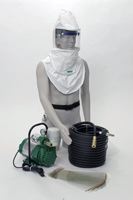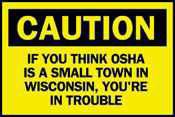 |
 |
| MSDS Topics |
Free Sites | FAQ's | Regulations | Glossary | Software | Suppliers |
| Books | Forum | Poll | Fun stuff | Quiz | Store | |
| MSDS and safety supplies | Search ALL our MSDS info | |||||
 | |||
 |
 |
 |
|
| Title:02/11/2004 - Application of the hazard communication standard to latex paints containing less than 6% crystalline silica. | |
| Record Type: Interpretation | Standard Number: 1910.1200 |
|
February 11, 2004
Ms. Allison Keane, Esq. Dear Ms. Keane: Thank you for your February 5, 2002 letter to Mr. Steven Witt, Director for the Occupational Safety and Health Administration's (OSHA's) Directorate of Standards and Guidance. Your letter was forwarded to OSHA's Directorate of Enforcement Programs (DEP); we received it on April 17, 2003. This letter constitutes OSHA's interpretation only of the requirements discussed and may not be applicable to any statement or scenario not delineated within your original correspondence. Specifically, you requested a letter of interpretation addressing eliminating the need for application of the Hazard Communication Standard (HCS) to latex paints containing less than 6 percent crystalline silica. We apologize for the delay in responding to your request. Please be assured that your inquiry has received very thorough consideration. |  When spray painting, sanding, or grinding, consider a complete supplied air respirator system like this one from Safety Emporium. |
Accompanying your letter was a study commissioned by the National Paint and Coatings Association (NPCA) to examine exposures of painters to crystalline silica during spray painting and sanding activities ("Exposure to Crystalline Silica and Estimation of the Associated Human Health Risks from Painting and Sanding Interior Flat Latex Paint," Radian International, September 11, 2000). As we understand from this study and your letter, flat latex paints can contain as much as 6 percent crystalline silica in the form of cristobalite, although most formulations contain less than 1 percent crystalline silica.
In this study, Radian International reported that crystalline silica was detected only in three breathing-zone air samples for respirable particulate taken during the sanding activities on surfaces painted with the 6 percent crystalline formulation; no respirable particulate was detected in any of the 0.1 and 0.5 formulations. Based on these results, it is NPCA members' belief that data from this study represent "a proper characterization of the range of anticipated downstream exposures..." Your letter requests that NPCA members be allowed to "accurately consider this data in the hazard determination process for its latex and paint products and those containing less than 6% crystalline silica." The request is made that flat paints containing less than 6 percent crystalline silica not be subject to the HCS information transmittal requirements.
| The Agency cannot grant this request, as it has stated from the outset that the HCS is based on the premise that chemicals have inherent characteristics that pose potential hazards and workers have the right to know what those potential hazards are. The concept of exempting a substance from coverage due to a determination of potential risk during downstream exposure was specifically rejected during the rulemaking process for the HCS. Also rejected was inclusion of a de minimis concept, i.e., that OSHA exempt releases of "small" amounts of a hazardous chemical during normal conditions use. These approaches are not consistent with the intent of the HCS to prevent effects from occurring by providing information prior to putting the employee at risk. |  SafetyEmporium.com carries both serious and humorous signs. |
Therefore, the manufacturer must consider that if normal conditions of use include actions such as grinding or sanding on a product that could release crystalline silica, then the product would be covered by the HCS, and the presence of silica must be indicated on the Material Safety Data Sheet, and appropriate warnings must appear on the label.
The Agency has further determined that the letter of interpretation dated March 15, 1989 entitled, "Application of the HCS to certain products containing crystalline silica" and referenced in your letter (copy attached), does not accurately represent OSHA's policy with regard to the HCS and will be withdrawn. Several other letters of interpretation which do support our policy and which are available on our website include: "Crystalline silica considered a carcinogen under the HCS" dated September 20, 1988; "Applicability of the HCS to crystalline silica, when bound in a polymeric compound and silicone rubber elastomers" dated February 8, 1989; "Regarding labeling requirements under the OSHA's Hazard Communication Standard" dated May 16, 1990; "Label requirements for crystalline silica" dated February 11, 1991; and "Provisions of the Hazard Communication Standard dated June 20, 1997. You may wish to refer to these letters for further clarification on our policy in regard to this issue.
|
Thank you for your interest in occupational safety and health. We hope you find this information helpful. OSHA requirements are set by statute, standards, and regulations. Our interpretation letters explain these requirements and how they apply to particular circumstances, but they cannot create additional employer obligations. This letter constitutes OSHA's interpretation of the requirements discussed. Note that ourenforcement guidance may be affected by changes to OSHA rules. Also, from time to time we update our guidance in response to new information. To keep apprised of such developments, you can consult OSHA's website at http://www.osha.gov. Sincerely,
Richard E. Fairfax, Director
|  These HazCom labels come in handy rolls of 500 at Safety Emporium. |
The official, public domain, OSHA version of this document is available at http://www.osha.gov/pls/oshaweb/owadisp.show_document?p_table=INTERPRETATIONS&p_id=24783&p_text_version=FALSE